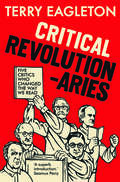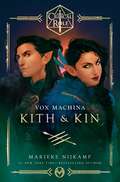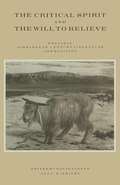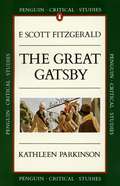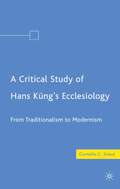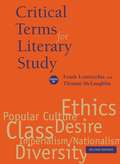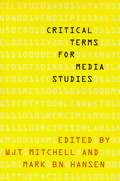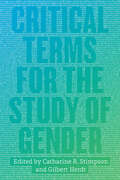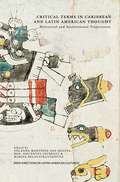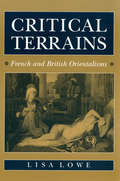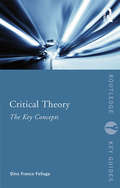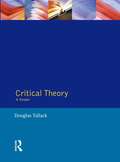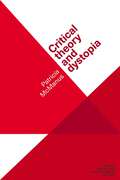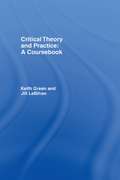- Table View
- List View
Critical Revolutionaries: Five Critics Who Changed the Way We Read
by Terry EagletonTerry Eagleton looks back across sixty years to an extraordinary critical milieu that transformed the study of literature Before the First World War, traditional literary scholarship was isolated from society at large. In the years following, a younger generation of critics came to the fore. Their work represented a reaction to the impoverishment of language in a commercial, utilitarian society increasingly under the sway of film, advertising, and the popular press. For them, literary criticism was a way of diagnosing social ills and had a vital moral function to perform. Terry Eagleton reflects on the lives and work of T. S. Eliot, I. A. Richards, William Empson, F. R. Leavis, and Raymond Williams, and explores a vital tradition of literary criticism that today is in danger of being neglected. These five critics rank among the most original and influential of modern times, and represent one of the most remarkable intellectual formations in twentieth-century Britain. This was the heyday of literary modernism, a period of change and experimentation—the bravura of which spurred on developments in critical theory.
Critical Role: Vox Machina – Kith & Kin (Critical Role Ser. #1)
by Cast of Critical Role Marieke NijkampExplore the past of Critical Role's daring half-elf twins, Vex'ahlia and Vax'ildan, in this original prequel novel to their adventures with Vox Machina.Vex and Vax have always been outsiders. A harsh childhood in the elite elven city of Syngorn quickly taught them not to rely on others. Now, freed from the expectations of their exacting father and the scornful eyes of Syngorn's elves, the cunning hunter and the conning thief have made their own way in the world of Exandria. The twins have traveled far and experienced great hardship. But with the help of Vex's quick wit and Vax's quicker dagger, they've always kept ahead of trouble. Now, unknown perils await them in the bustling city of Westruun, where the twins become entangled in a web spun by the thieves' guild known to many as the Clasp. Trapped by a hasty deal, Vex and Vax (along with Vex's faithful bear companion, Trinket) set out into the wilds to fulfill their debt to the infamous crime syndicate. As the situation grows more complicated than they ever could have imagined, for the first time Vex and Vax find themselves on opposite sides of a conflict that threatens the home they have carried with each other for years.Written by #1 New York Times bestselling author Marieke Nijkamp, Critical Role: Vox Machina-Kith & Kin follows a brand-new adventure that delves into the twin's unexplored history, and returns to some of the iconic moments that forged Vox Machina's most unbreakable bond.
The Critical Spirit and the Will to Believe: Essays in Nineteenth-Century Literature and Religion (pdf)
by D. Jasper Sharon McGuire T R WrightCritical Studies: The Great Gatsby (The Great Gatsby)
by Kathleen ParkinsonKathleen Parkinson places this brilliant and bitter satire on the moral failure of the Jazz Age firmly in the context of Scott Fitzgerald's life and times. She explores the intricate patterns of the novel, its chronology, locations, imagery and use of colour, and how these contribute to a seamless interplay of social comedy and symbolic landscape. She devotes a perceptive chapter to Fitzgerald's controversial portrayal of women and goes on to discuss how the central characters, Gatsby and Nick Carraway, embody and confront the dualism inherent in the American dream.
A Critical Study of Hans Küng’s Ecclesiology: From Traditionalism to Modernism
by C. SimutThe book presents the transition from traditionalism to modernism in connection to two of Küng's most important books on ecclesiology: Structures of the Church (1962) as representing Küng's traditional theology, and On Being a Christian (1974) as a reflection of his modern approach to Christianity.
Critical Terms for Literary Study, Second Edition (Critical Terms)
by Lentricchia, Frank and McLaughlin, ThomasSince its publication in 1990, Critical Terms for Literary Study has become a landmark introduction to the work of literary theory—giving tens of thousands of students an unparalleled encounter with what it means to do theory and criticism. Significantly expanded, this new edition features six new chapters that confront, in different ways, the growing understanding of literary works as cultural practices. These six new chapters are "Popular Culture," "Diversity," "Imperialism/Nationalism," "Desire," "Ethics," and "Class," by John Fiske, Louis Menand, Seamus Deane, Judith Butler, Geoffrey Galt Harpham, and Daniel T. O'Hara, respectively. Each new essay adopts the approach that has won this book such widespread acclaim: each provides a concise history of a literary term, critically explores the issues and questions the term raises, and then puts theory into practice by showing the reading strategies the term permits. Exploring the concepts that shape the way we read, the essays combine to provide an extraordinary introduction to the work of literature and literary study, as the nation's most distinguished scholars put the tools of critical practice vividly to use.
Critical Terms for Media Studies (Critical Terms)
by W. J. T. Mitchell Mark B. N. HansenCommunications, philosophy, film and video, digital culture: media studies straddles an astounding array of fields and disciplines and produces a vocabulary that is in equal parts rigorous and intuitive. Critical Terms for Media Studies defines, and at times, redefines, what this new and hybrid area aims to do, illuminating the key concepts behind its liveliest debates and most dynamic topics. Part of a larger conversation that engages culture, technology, and politics, this exciting collection of essays explores our most critical language for dealing with the qualities and modes of contemporary media. Edited by two outstanding scholars in the field, W. J. T. Mitchell and Mark B. N. Hansen, the volume features works by a team of distinguished contributors. These essays, commissioned expressly for this volume, are organized into three interrelated groups: “Aesthetics” engages with terms that describe sensory experiences and judgments, “Technology” offers entry into a broad array of technological concepts, and “Society” opens up language describing the systems that allow a medium to function. A compelling reference work for the twenty-first century and the media that form our experience within it, Critical Terms for Media Studies will engage and deepen any reader’s knowledge of one of our most important new fields.
Critical Terms for Media Studies (Critical Terms)
by W. J. T. Mitchell Mark B. N. HansenCommunications, philosophy, film and video, digital culture: media studies straddles an astounding array of fields and disciplines and produces a vocabulary that is in equal parts rigorous and intuitive. Critical Terms for Media Studies defines, and at times, redefines, what this new and hybrid area aims to do, illuminating the key concepts behind its liveliest debates and most dynamic topics. Part of a larger conversation that engages culture, technology, and politics, this exciting collection of essays explores our most critical language for dealing with the qualities and modes of contemporary media. Edited by two outstanding scholars in the field, W. J. T. Mitchell and Mark B. N. Hansen, the volume features works by a team of distinguished contributors. These essays, commissioned expressly for this volume, are organized into three interrelated groups: “Aesthetics” engages with terms that describe sensory experiences and judgments, “Technology” offers entry into a broad array of technological concepts, and “Society” opens up language describing the systems that allow a medium to function. A compelling reference work for the twenty-first century and the media that form our experience within it, Critical Terms for Media Studies will engage and deepen any reader’s knowledge of one of our most important new fields.
Critical Terms for Media Studies (Critical Terms)
by W. J. T. Mitchell Mark B. N. HansenCommunications, philosophy, film and video, digital culture: media studies straddles an astounding array of fields and disciplines and produces a vocabulary that is in equal parts rigorous and intuitive. Critical Terms for Media Studies defines, and at times, redefines, what this new and hybrid area aims to do, illuminating the key concepts behind its liveliest debates and most dynamic topics. Part of a larger conversation that engages culture, technology, and politics, this exciting collection of essays explores our most critical language for dealing with the qualities and modes of contemporary media. Edited by two outstanding scholars in the field, W. J. T. Mitchell and Mark B. N. Hansen, the volume features works by a team of distinguished contributors. These essays, commissioned expressly for this volume, are organized into three interrelated groups: “Aesthetics” engages with terms that describe sensory experiences and judgments, “Technology” offers entry into a broad array of technological concepts, and “Society” opens up language describing the systems that allow a medium to function. A compelling reference work for the twenty-first century and the media that form our experience within it, Critical Terms for Media Studies will engage and deepen any reader’s knowledge of one of our most important new fields.
Critical Terms for the Study of Gender (Critical Terms)
by Catharine R. Stimpson and Gilbert Herdt“Gender systems pervade and regulate human lives—in law courts and operating rooms, ballparks and poker clubs, hair-dressing salons and kitchens, classrooms and playgroups. . . . Exactly how gender works varies from culture to culture, and from historical period to historical period, but gender is very rarely not at work. Nor does gender operate in isolation. It is linked to other social structures and sources of identity.” So write women’s studies pioneer Catharine R. Stimpson and anthropologist Gilbert Herdt in their introduction to Critical Terms for the Study of Gender, laying out the wide-ranging nature of this interdisciplinary and rapidly changing field. The sixth in the series of “Critical Terms” books, this volume provides an indispensable introduction to the study of gender through an exploration of key terms that are a part of everyday discourse in this vital subject. Following Stimpson and Herdt’s careful account of the evolution of gender studies and its relation to women’s and sexuality studies, the twenty-one essays here cast an appropriately broad net, spanning the study of gender and sexuality across the humanities and social sciences. Written by a distinguished group of scholars, each essay presents students with a history of a given term—from bodies to utopia—and explains the conceptual baggage it carries and the kinds of critical work it can be made to do. The contributors offer incisive discussions of topics ranging from desire, identity, justice, and kinship to love, race, and religion that suggest new directions for the understanding of gender studies. The result is an essential reference addressed to students studying gender in very different disciplinary contexts.
Critical Terms for the Study of Gender (Critical Terms)
by Catharine R. Stimpson and Gilbert Herdt“Gender systems pervade and regulate human lives—in law courts and operating rooms, ballparks and poker clubs, hair-dressing salons and kitchens, classrooms and playgroups. . . . Exactly how gender works varies from culture to culture, and from historical period to historical period, but gender is very rarely not at work. Nor does gender operate in isolation. It is linked to other social structures and sources of identity.” So write women’s studies pioneer Catharine R. Stimpson and anthropologist Gilbert Herdt in their introduction to Critical Terms for the Study of Gender, laying out the wide-ranging nature of this interdisciplinary and rapidly changing field. The sixth in the series of “Critical Terms” books, this volume provides an indispensable introduction to the study of gender through an exploration of key terms that are a part of everyday discourse in this vital subject. Following Stimpson and Herdt’s careful account of the evolution of gender studies and its relation to women’s and sexuality studies, the twenty-one essays here cast an appropriately broad net, spanning the study of gender and sexuality across the humanities and social sciences. Written by a distinguished group of scholars, each essay presents students with a history of a given term—from bodies to utopia—and explains the conceptual baggage it carries and the kinds of critical work it can be made to do. The contributors offer incisive discussions of topics ranging from desire, identity, justice, and kinship to love, race, and religion that suggest new directions for the understanding of gender studies. The result is an essential reference addressed to students studying gender in very different disciplinary contexts.
Critical Terms for the Study of Gender (Critical Terms)
by Catharine R. Stimpson and Gilbert Herdt“Gender systems pervade and regulate human lives—in law courts and operating rooms, ballparks and poker clubs, hair-dressing salons and kitchens, classrooms and playgroups. . . . Exactly how gender works varies from culture to culture, and from historical period to historical period, but gender is very rarely not at work. Nor does gender operate in isolation. It is linked to other social structures and sources of identity.” So write women’s studies pioneer Catharine R. Stimpson and anthropologist Gilbert Herdt in their introduction to Critical Terms for the Study of Gender, laying out the wide-ranging nature of this interdisciplinary and rapidly changing field. The sixth in the series of “Critical Terms” books, this volume provides an indispensable introduction to the study of gender through an exploration of key terms that are a part of everyday discourse in this vital subject. Following Stimpson and Herdt’s careful account of the evolution of gender studies and its relation to women’s and sexuality studies, the twenty-one essays here cast an appropriately broad net, spanning the study of gender and sexuality across the humanities and social sciences. Written by a distinguished group of scholars, each essay presents students with a history of a given term—from bodies to utopia—and explains the conceptual baggage it carries and the kinds of critical work it can be made to do. The contributors offer incisive discussions of topics ranging from desire, identity, justice, and kinship to love, race, and religion that suggest new directions for the understanding of gender studies. The result is an essential reference addressed to students studying gender in very different disciplinary contexts.
Critical Terms for the Study of Gender (Critical Terms)
by Catharine R. Stimpson Gilbert Herdt“Gender systems pervade and regulate human lives—in law courts and operating rooms, ballparks and poker clubs, hair-dressing salons and kitchens, classrooms and playgroups. . . . Exactly how gender works varies from culture to culture, and from historical period to historical period, but gender is very rarely not at work. Nor does gender operate in isolation. It is linked to other social structures and sources of identity.” So write women’s studies pioneer Catharine R. Stimpson and anthropologist Gilbert Herdt in their introduction to Critical Terms for the Study of Gender, laying out the wide-ranging nature of this interdisciplinary and rapidly changing field. The sixth in the series of “Critical Terms” books, this volume provides an indispensable introduction to the study of gender through an exploration of key terms that are a part of everyday discourse in this vital subject. Following Stimpson and Herdt’s careful account of the evolution of gender studies and its relation to women’s and sexuality studies, the twenty-one essays here cast an appropriately broad net, spanning the study of gender and sexuality across the humanities and social sciences. Written by a distinguished group of scholars, each essay presents students with a history of a given term—from bodies to utopia—and explains the conceptual baggage it carries and the kinds of critical work it can be made to do. The contributors offer incisive discussions of topics ranging from desire, identity, justice, and kinship to love, race, and religion that suggest new directions for the understanding of gender studies. The result is an essential reference addressed to students studying gender in very different disciplinary contexts.
Critical Terms for the Study of Gender (Critical Terms)
by Catharine R. Stimpson Gilbert Herdt“Gender systems pervade and regulate human lives—in law courts and operating rooms, ballparks and poker clubs, hair-dressing salons and kitchens, classrooms and playgroups. . . . Exactly how gender works varies from culture to culture, and from historical period to historical period, but gender is very rarely not at work. Nor does gender operate in isolation. It is linked to other social structures and sources of identity.” So write women’s studies pioneer Catharine R. Stimpson and anthropologist Gilbert Herdt in their introduction to Critical Terms for the Study of Gender, laying out the wide-ranging nature of this interdisciplinary and rapidly changing field. The sixth in the series of “Critical Terms” books, this volume provides an indispensable introduction to the study of gender through an exploration of key terms that are a part of everyday discourse in this vital subject. Following Stimpson and Herdt’s careful account of the evolution of gender studies and its relation to women’s and sexuality studies, the twenty-one essays here cast an appropriately broad net, spanning the study of gender and sexuality across the humanities and social sciences. Written by a distinguished group of scholars, each essay presents students with a history of a given term—from bodies to utopia—and explains the conceptual baggage it carries and the kinds of critical work it can be made to do. The contributors offer incisive discussions of topics ranging from desire, identity, justice, and kinship to love, race, and religion that suggest new directions for the understanding of gender studies. The result is an essential reference addressed to students studying gender in very different disciplinary contexts.
Critical Terms for the Study of Gender (Critical Terms)
“Gender systems pervade and regulate human lives—in law courts and operating rooms, ballparks and poker clubs, hair-dressing salons and kitchens, classrooms and playgroups. . . . Exactly how gender works varies from culture to culture, and from historical period to historical period, but gender is very rarely not at work. Nor does gender operate in isolation. It is linked to other social structures and sources of identity.” So write women’s studies pioneer Catharine R. Stimpson and anthropologist Gilbert Herdt in their introduction to Critical Terms for the Study of Gender, laying out the wide-ranging nature of this interdisciplinary and rapidly changing field. The sixth in the series of “Critical Terms” books, this volume provides an indispensable introduction to the study of gender through an exploration of key terms that are a part of everyday discourse in this vital subject. Following Stimpson and Herdt’s careful account of the evolution of gender studies and its relation to women’s and sexuality studies, the twenty-one essays here cast an appropriately broad net, spanning the study of gender and sexuality across the humanities and social sciences. Written by a distinguished group of scholars, each essay presents students with a history of a given term—from bodies to utopia—and explains the conceptual baggage it carries and the kinds of critical work it can be made to do. The contributors offer incisive discussions of topics ranging from desire, identity, justice, and kinship to love, race, and religion that suggest new directions for the understanding of gender studies. The result is an essential reference addressed to students studying gender in very different disciplinary contexts.
Critical Terms in Caribbean and Latin American Thought: Historical and Institutional Trajectories (New Directions in Latino American Cultures)
by Ben. Sifuentes-Jáuregui Yolanda Martínez-San Miguel Marisa BelausteguigoitiaThrough a collection of critical essays, this work explores twelve keywords central in Latin American and Caribbean Studies: indigenismo, Americanism, colonialism, criollismo, race, transculturation, modernity, nation, gender, sexuality, testimonio, and popular culture. The central question motivating this work is how to think—epistemologically and pedagogically—about Latin American and Caribbean Studies as fields that have had different historical and institutional trajectories across the Caribbean, Latin America, and the United States.
Critical Terrains: French and British Orientalisms
by Lisa LoweExamining and historicizing the concept of "otherness" in both literature and criticism, Lisa Lowe explores representations of non-European cultures in British and French writings from the eighteenth through the twentieth century. Lowe traces the intersections of culture, class, and sexuality in Lady Mary Wortley Montagu’s Turkish Embassy Letters and Montesquieu’s Lettres persanes and discusses tropes of orientalism, racialism, and romanticism in Flaubert. She then turns to debates in Anglo-American and Indian criticism on Forster’s Passage to India and on the utopian projection of China in the poststructuralist theories of Julia Kristeva and Roland Barthes and in the journal Tel Quel.
Critical Theory: The Key Concepts (Routledge Key Guides)
by Dino Franco FellugaCritical Theory: The Key Concepts introduces over 300 widely-used terms, categories and ideas drawing upon well-established approaches like new historicism, postmodernism, psychoanalysis, Marxism, and narratology as well as many new critical theories of the last twenty years such as Actor-Network Theory, Global Studies, Critical Race Theory, and Speculative Realism. This book explains the key concepts at the heart of a wide range of influential theorists from Agamben to Žižek. Entries range from concise definitions to longer more explanatory essays and include terms such as: Aesthetics Desire Dissensus Dromocracy Hegemony Ideology Intersectionality Late Capitalism Performativity Race Suture Featuring cross-referencing throughout, a substantial bibliography and index, Critical Theory: The Key Concepts is an accessible and easy-to-use guide. This book is an invaluable introduction covering a wide range of subjects for anyone who is studying or has an interest in critical theory (past and present).
Critical Theory: The Key Concepts (Routledge Key Guides)
by Dino Franco FellugaCritical Theory: The Key Concepts introduces over 300 widely-used terms, categories and ideas drawing upon well-established approaches like new historicism, postmodernism, psychoanalysis, Marxism, and narratology as well as many new critical theories of the last twenty years such as Actor-Network Theory, Global Studies, Critical Race Theory, and Speculative Realism. This book explains the key concepts at the heart of a wide range of influential theorists from Agamben to Žižek. Entries range from concise definitions to longer more explanatory essays and include terms such as: Aesthetics Desire Dissensus Dromocracy Hegemony Ideology Intersectionality Late Capitalism Performativity Race Suture Featuring cross-referencing throughout, a substantial bibliography and index, Critical Theory: The Key Concepts is an accessible and easy-to-use guide. This book is an invaluable introduction covering a wide range of subjects for anyone who is studying or has an interest in critical theory (past and present).
Critical Theory: A Reader
by Douglas TallackAn anthology of readings and extracts providing a comprehensive introduction to the main schools and positions of critical theory. The book is divided into five sections; structuralism and poststructuralism, psychoanalytical theory, Marxism, feminism, and post-foundational ethics and politics. It includes a general introduction covering the field of critical theory and identifies founding theorists and movements with a bibliography and notes.
Critical Theory: A Reader
by Douglas TallackAn anthology of readings and extracts providing a comprehensive introduction to the main schools and positions of critical theory. The book is divided into five sections; structuralism and poststructuralism, psychoanalytical theory, Marxism, feminism, and post-foundational ethics and politics. It includes a general introduction covering the field of critical theory and identifies founding theorists and movements with a bibliography and notes.
Critical theory and dystopia (Critical Theory and Contemporary Society)
by Patricia McManusCritical theory and dystopia offers a uniquely rich study of dystopian fiction, drawing on the insights of critical theory. Asking what ideological work these dark imaginings perform, the book reconstructs the historical emergence, consolidation and transformation of the genre across the twentieth century and into our own, ranging from Yevgeny Zamayatin’s We (1924) and Aldous Huxley’s Brave New World (1932) to Anthony Burgess’s A Clockwork Orange (1963) and Suzanne Collins's Hunger Games series (2000s and 2010s). In doing so, it reveals the political logics opened up or neutered by the successive moments of this dystopian history.
Critical theory and dystopia (Critical Theory and Contemporary Society)
by Patricia McManusCritical theory and dystopia offers a uniquely rich study of dystopian fiction, drawing on the insights of critical theory. Asking what ideological work these dark imaginings perform, the book reconstructs the historical emergence, consolidation and transformation of the genre across the twentieth century and into our own, ranging from Yevgeny Zamayatin’s We (1924) and Aldous Huxley’s Brave New World (1932) to Anthony Burgess’s A Clockwork Orange (1963) and Suzanne Collins's Hunger Games series (2000s and 2010s). In doing so, it reveals the political logics opened up or neutered by the successive moments of this dystopian history.
Critical Theory and Practice: A Coursebook
by Keith Green Jill LeBihanCritical Teory and Practice answers lots of questions, but also stimulates new ones. Its tailor-made combination of survey, reader and workbook is ideal for the beginning - perhaps even bewildered - student of literary theory. The work is divided into seven chapters, each of which contains guiding commentary, examples from literary and critical works, and a variety of exercises to provoke and engage you. Each chapter includes a glossary and annotated selection of suggested further reading. There is also a full bibliography. The authors cover the key issues and debates of literary theory, including: * Language, Linguistics and Literature * Structures of Literature * Literature and History * Subjectivity, Psychoanalysis and Criticism * Reading, Writing and Reception * Women, Literature and Criticism * Literature, Criticism and Cultural Identity Critical Theory and Practice is an refreshingly clear, up-to-date and eminently readable introduction to the subject. It not only guides you through the terminology and gives you a selection of the key passages to read, it also helps you engage with the theory and apply it in practice.
Critical Theory and Practice: A Coursebook
by Keith Green Jill LeBihanCritical Teory and Practice answers lots of questions, but also stimulates new ones. Its tailor-made combination of survey, reader and workbook is ideal for the beginning - perhaps even bewildered - student of literary theory. The work is divided into seven chapters, each of which contains guiding commentary, examples from literary and critical works, and a variety of exercises to provoke and engage you. Each chapter includes a glossary and annotated selection of suggested further reading. There is also a full bibliography. The authors cover the key issues and debates of literary theory, including: * Language, Linguistics and Literature * Structures of Literature * Literature and History * Subjectivity, Psychoanalysis and Criticism * Reading, Writing and Reception * Women, Literature and Criticism * Literature, Criticism and Cultural Identity Critical Theory and Practice is an refreshingly clear, up-to-date and eminently readable introduction to the subject. It not only guides you through the terminology and gives you a selection of the key passages to read, it also helps you engage with the theory and apply it in practice.
